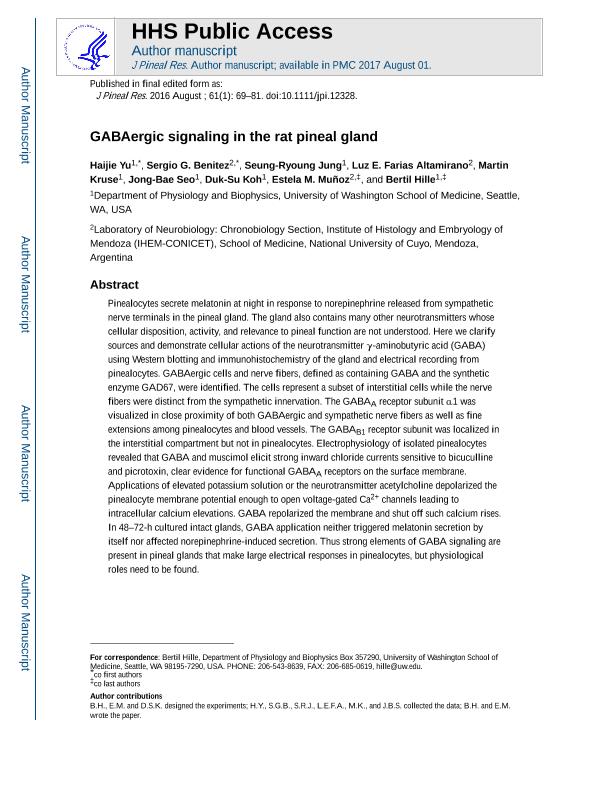Artículo
GABAergic signaling in the rat pineal gland
Yu, Haijie; Benitez, Sergio Gonzalo ; Jung, Seung-Ryoung; Kruse, Martin; Seo, Jong Bae; Koh, Duk-Su; Muñoz, Estela Maris
; Jung, Seung-Ryoung; Kruse, Martin; Seo, Jong Bae; Koh, Duk-Su; Muñoz, Estela Maris ; Hille, Bertil
; Hille, Bertil
 ; Jung, Seung-Ryoung; Kruse, Martin; Seo, Jong Bae; Koh, Duk-Su; Muñoz, Estela Maris
; Jung, Seung-Ryoung; Kruse, Martin; Seo, Jong Bae; Koh, Duk-Su; Muñoz, Estela Maris ; Hille, Bertil
; Hille, Bertil
Fecha de publicación:
08/2016
Editorial:
Wiley Blackwell Publishing, Inc
Revista:
Journal of Pineal Research
ISSN:
0742-3098
Idioma:
Inglés
Tipo de recurso:
Artículo publicado
Clasificación temática:
Resumen
Pinealocytes secrete melatonin at night in response to norepinephrine released from sympathetic nerve terminals in the pineal gland. The gland also contains many other neurotransmitters whose cellular disposition, activity, and relevance to pineal function are not understood. Here, we clarify sources and demonstrate cellular actions of the neurotransmitter γ-aminobutyric acid (GABA) using Western blotting and immunohistochemistry of the gland and electrical recording from pinealocytes. GABAergic cells and nerve fibers, defined as containing GABA and the synthetic GAD67, were identified. The cells represent a subset of interstitial cells while the nerve fibers were distinct from the sympathetic innervation. The GABAA receptor subunit α1 was visualized in close proximity of both GABAergic and sympathetic nerve fibers as well as fine extensions among pinealocytes and blood vessels. The GABAB 1 receptor subunit was localized in the interstitial compartment but not in pinealocytes. Electrophysiology of isolated pinealocytes revealed that GABA and muscimol elicit strong inward chloride currents sensitive to bicuculline and picrotoxin, clear evidence for functional GABAA receptors on the surface membrane. Applications of elevated potassium solution or the neurotransmitter acetylcholine depolarized the pinealocyte membrane potential enough to open voltage-gated Ca2+ channels leading to intracellular calcium elevations. GABA repolarized the membrane and shut off such calcium rises. In 48–72-h cultured intact glands, GABA application neither triggered melatonin secretion by itself nor affected norepinephrine-induced secretion. Thus, strong elements of GABA signaling are present in pineal glands that make large electrical responses in pinealocytes, but physiological roles need to be found.
Archivos asociados
Licencia
Identificadores
Colecciones
Articulos(IHEM)
Articulos de INST. HISTOLOGIA Y EMBRIOLOGIA DE MEND DR.M.BURGOS
Articulos de INST. HISTOLOGIA Y EMBRIOLOGIA DE MEND DR.M.BURGOS
Citación
Yu, Haijie; Benitez, Sergio Gonzalo; Jung, Seung-Ryoung; Kruse, Martin; Seo, Jong Bae; et al.; GABAergic signaling in the rat pineal gland; Wiley Blackwell Publishing, Inc; Journal of Pineal Research; 61; 1; 8-2016; 69-81
Compartir
Altmétricas



